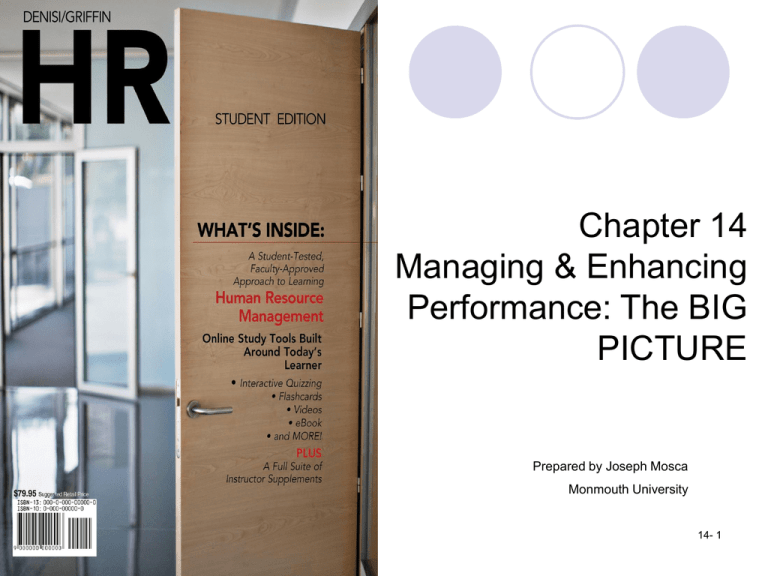
Chapter 14
Managing & Enhancing
Performance: The BIG
PICTURE
Prepared by Joseph Mosca
Monmouth University
Copyright © 2012 by Cengage Learning. All rights reserved.
14- 1
Learning Objectives
1.
2.
3.
4.
5.
Describe the relationships among performance measured at
different levels within an organization and discuss how
training, development, and job design can help improve
performance.
Discuss the role of alternate work arrangements in
motivating and enhancing performance.
Describe the role of incentive pay and identify programs for
individual-based and team-based incentive plans.
Discuss the best ways to deliver performance feedback and
the issues involved with feedback and describe the basic
operation of ProMES system.
Discuss how organizations evaluate performanceenhancement programs.
Copyright © 2012 by Cengage Learning. All rights reserved.
14- 2
Training and Development
Training is a planned
attempt by an
organization to facilitate
employee learning of
job-related knowledge,
skills, and behaviors.
Development refers
to teaching managers
and professionals the
skills needed for both
present and future jobs.
Copyright © 2012 by Cengage Learning. All rights reserved.
14- 3
Job Redesign
Job rotation involves systematically
moving employees from one job to another.
Job enlargement was developed to increase
the total number of tasks workers perform
based on the assumption that doing the same
basic task over and over is the primary cause
of worker dissatisfaction.
Job enrichment attempts to increase both
the number of tasks a worker does and the
control the worker has over the job.
Copyright © 2012 by Cengage Learning. All rights reserved.
14- 4
The Job Characteristics Approach
The Job Characteristics Approach is
an alternative to job specialization that
takes into account the work system and
employee preferences. It suggests that
jobs should be diagnosed/improved
along 5 core dimensions:
1.
2.
3.
4.
5.
Skill variety
Task variety
Task significance
Autonomy
Feedback
Copyright © 2012 by Cengage Learning. All rights reserved.
14- 5
Alternative Work Arrangements
Flexible work hours programs involve
employees working forty hours per week
and five days a week, but with the
potential for flexible starting and ending
times.
Compressed workweeks are
arrangements where the employee works
the required number of hours (typically
forty) but does so in less than five days.
Copyright © 2012 by Cengage Learning. All rights reserved.
14- 6
Alternative Work Sites
Home work programs or cottage industries
exist for manufacturing of small and noncomplex items.
Telecommuting, use of electronic
equipment to perform work traditionally
done at the work place.
Copyright © 2012 by Cengage Learning. All rights reserved.
14- 7
Beyond the Book: Keys for Successful
Telecommuting
Identify jobs best suited for
telecommuting.
Select responsible employees.
Establish procedures.
Establish a training program.
Keep telecommuters informed.
Recognize when telecommuting does not
work.
Copyright © 2012 by Cengage Learning. All rights reserved.
14- 8
Incentives and Performance Based
Rewards
Merit pay is pay awarded
to employees on the basis of
the relative value of their
contributions to the
organization.
Merit pay plans are
compensation plans that
formally base at least some
meaningful portion of
compensation on merit.
Copyright © 2012 by Cengage Learning. All rights reserved.
14- 9
Team and Group Incentive Plans
Gain-sharing is a team
and group incentive system
designed to share with
employees the cost
savings from productivity
improvements.
Scanlon plans are gainsharing plans where teams
and groups of employees
are encouraged to suggest
strategies for reducing
costs and gains.
Copyright © 2012 by Cengage Learning. All rights reserved.
14- 10
Team and Group Incentive Plans (cont’d)
Profit sharing is an incentive system in
which, at the end of the year, some portion
of profits are paid into a profit sharing pool.
Stock option plans give senior managers
an opportunity to purchase company
stock.
In Employee stock ownership plans
(ESOPs) employees are gradually given a
major stake in the ownership of a
corporation.
Copyright © 2012 by Cengage Learning. All rights reserved.
14- 11
Performance Management and
Feedback
Productivity Measurement and
Evaluation System (ProMES) is a
program developed to improve group- or
firm-level productivity. This approach
incorporates ideas from goal setting, with
incentives for improvement, and is based
on a model of motivation similar to
expectancy theory.
Copyright © 2012 by Cengage Learning. All rights reserved.
14- 12




